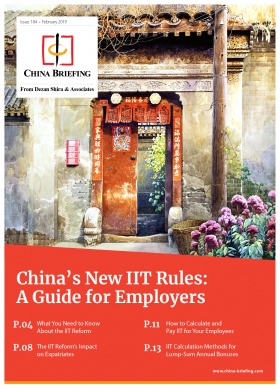Can China Develop its Own Digital Infrastructure Without US Assistance?
Op/Ed by Chris Devonshire-Ellis
With the United States having banned certain component parts from being sold to China, targeting Huawei in particular, the media has been analyzing the implications. An excellent article in the Financial Times, “How Blacklisting Affects the Inside of a Huawei Smartphone” contains a cool analysis of where component parts are manufactured and where the intellectual property (IP) originates from.
Not all of it is from the US, with British and South Korean technology also involved. Taiwan, much lauded as a potential alternative to China, is mainly concentrated on the assembly part, which although it requires precision, can be relocated elsewhere. Taiwan’s policy of utilizing manufacturing clusters in the assembly of these technologies to make a specific unit is a smart business ploy and also useful in attracting a cluster of foreign investors. Many of those investors are US companies.
China is unlikely to shift production of components to Taiwan because (a) it doesn’t need to – it has plenty of capable assembly plants of its own, (b) the island is still considered a renegade province, and (c) it remains heavily supported by the US. Chinese technology would not be safe in Taiwan and could land the country in numerous IP lawsuits as well, once the Americans have had a good look at what is inside. On the other hand, China wouldn’t want the US looking into Chinese innovations too easily either.
However, the question concerning “digital infrastructure” runs a lot further than just the insides of smartphones. The 5G network, which will revolutionize communications in everything from much faster download speeds, to intelligent, driver-less cars, is already here. The US ban on selling components to Huawei will slow down some of the global roll-out (intended to be next year) but the technology already exists. It’s just that the US owns many of the IP patents and technology needed to make the equipment. Can China step up to make the grade on its own and without the US?
In many ways, the answer is yes, and is the same for several other countries too. Measuring “digital infrastructure” is quite easy, just by asking which countries already possess their own search engines and their own social networks. There are five: The US, China, Japan, South Korea, and Russia. India, which probably should be in the loop, isn’t, as its social network is dominated by Facebook, where the country has the largest number of subscribers in the world, at 241 million – more than the US itself.
No doubt, in time, the new Modi government will want to get around to correcting that. In terms of other nations wanting to help China substitute its dependency on US technologies, Japan can probably be crossed off the list as they will want to maintain a competitive advantage over China, while South Korea will probably sit on the fence and permit some collaboration. That leaves Russia.
The issue with Russia is that while the US is dismissive over Russian capabilities, the sanctions it introduced in 2014 are interfering negatively in how far Washington can understand what is going on there. Trade is minimal, diplomatic ties are in deep freeze, and US businesses are banned from buying high-tech Russian products. Five years later, that has created a knowledge gap.
Those five years are important, because according to the FT article I mentioned earlier, Chinese technology companies are 10 years behind the US in terms of developing the high-end logic chips of the type needed to power 5G. If that’s true, then Russia is halfway there as a leading nation in the development of artificial intelligence (AI), which is a core industry for the Russian state, benefiting from serious financial development funding.
It should also be noted that, at present, Russia has one of the world’s most active space programs. The technology coming out of that program is conveniently forgotten by Washington yet is being worked upon in Russia’s own Silicon Valley at Zelonograd, just outside Moscow. And who partnered with Russia over semiconductors after the US ban on selling technology to Russia in 2014? China’s Aerospace, Science, and Industry Corporation, meaning China and Russia have been working together on both the development and catch up with the US for the past five years – a time gap that can also be closed with increasing investment. Both have signaled their intention to take up the majority of global AI business development, as I covered in the article “Russia, China Aim to Take Majority of Global AI Development Opportunities“.
India too, will probably want to be on board, although they will have a lot to do to develop their own national networks instead of being reliant on Facebook. That decision robbed India’s own IT industry of moving ahead with technologies to compete and innovate and has rendered it largely impotent in terms of creating its own digital infrastructure. With Prime Minister Modi just re-elected, and US President Trump being belligerent about Indian trade and also threatening tariffs on Indian products, a rather more nationalistic groundswell could begin in India seeking to develop their own social media networks. If so, that technology will come from Russia and China.
The fact that Russia and China have already begun working on such technologies since 2014 suggests that the US probably isn’t as up to date in its intelligence gathering as to assess the exact state of Chinese and Russian technologies in the digital sphere. An assumption that the Americans are “10 years ahead” is still just that – an assumption. The truth is no one really knows – except the Chinese and the Russians.
Huawei and the Chinese government themselves have already hinted that they “are prepared” to deal with any US shortfall. Meanwhile, developing digital and AI technologies in countries such as Russia is going to keep the US very much at arm’s length about the extent and sophistication levels that have already been and will be reached. The race for the control of the next generation of technology has become all rather cloak-and-dagger.
What does all this mean? It’s hard to say. Perhaps two scenarios – a global version of the struggle between Betamax and VHS in the dark old days of video home entertainment, when two similar, yet incompatible systems vied for dominance. VHS, an inferior quality product, won that battle, albeit with US funding of JVC via RCA, a telling detail of US economic issues effectively promoting a lesser, not better technology. Could the West and the East be divided along technological grounds? If so, whose will work best?
Alternatively, it could become a situation of the haves and have nots, at least for a couple of generations. The US has shown it is prepared to throw a spanner in the plans for global 5G if it doesn’t get the chance to build the new global network. Will it work? Can China step up with Russian assistance or will the US be dominant by using its trade and tariff mechanisms to foil the ambitions of Beijing and Moscow?
At the end of the day, it boils down to what many suggest remains a political struggle: should global communications be run by a democratic, capitalist driven system or a communist, authoritarian system? And if governments can be kept out of technologies that basically only count in 0s and 1s, which political system would be better to run it? There are two parts to this as far as I can see. The communists would probably make a better job of operating it, but I’d also like the freedom to articulate my opinions.
Regrettably, the current state of much of global media and the behavior of certain democratic institutions and individuals are now impinging upon that, bringing democracy closer to the communist perspective as concerns freedom of speech. That has undoubtedly tended to cloud the decision-making process as both now appear rather more similar than was previously the case. Social media has, after all, a hugely significant anti-social component part.
So how to summarize? Perhaps, put simply, the political struggle, or “people’s revolution” over who is best to operate the world is still going on. No one has won yet, neither the democracies, nor the communists, and perhaps that’s the best option – to maintain the ideological choice as a global norm.
About Us
China Briefing is published by Dezan Shira & Associates. Chris Devonshire-Ellis is the practice’ Chairman. The firm assists foreign investors in China, as well as India, the ASEAN countries, and Russia, and maintains 28 full-time regional offices. Please contact us at china@dezshira.com or visit us at www.dezshira.com.
- Previous Article China Set to Cash in on New African Free Trade Agreement
- Next Article Investing in Zhejiang Province: A Quick Guide for Foreign Investors







